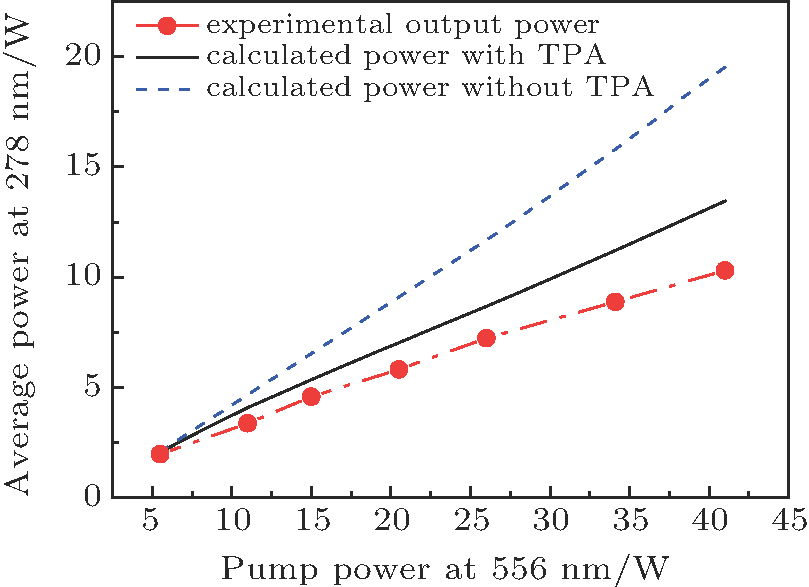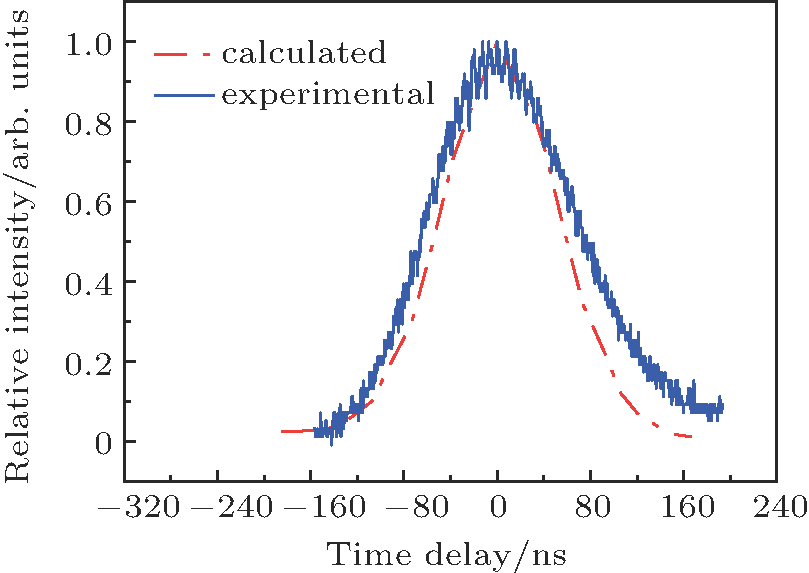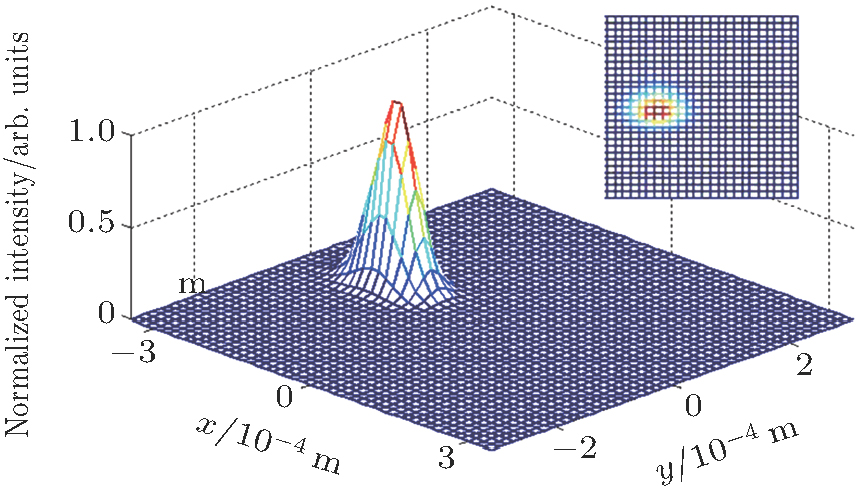† Corresponding author. E-mail:
Project supported by the National Natural Science Foundation Program of China (Grant Nos. 11504389 and 61505226), the National Key Research Development Program of China (Grant Nos. 2016YFB040203 and 61535013), and the National Development Project for Major Scientific Research Facility of China (Grant No. ZDYZ2012-2).
We report on the experimental investigation and theoretical analysis of a nanosecond pulse high power ultraviolet (UV) 278 nm laser by fourth-harmonic generation (FHG) of a 1112-nm Nd:YAG amplifier in LiB3O5 (LBO) and CsB3O5 (CBO) crystals. The UV laser delivers a maximum average power of 10.3 W at 278 nm with peak power of 36.8 kW under input pump power of 41 W at 556 nm. This is, to the best of our knowledge, the highest output power at the specific UV wavelength of 278 nm. We also performed the theoretical investigation on the FHG with a model in the Gaussian approximation of both spatial and temporal profiles, especially accounting for the two-photon absorption effect in CBO crystal for the first time. The average output power, pulse width, and beam spatial distribution of the UV laser were simulated. The theoretical calculations are in close agreement with the experimental results.
High power all-solid-state ultraviolet (UV) lasers have been in demand for various industrial and scientific applications, such as laser marking, drilling, cutting on printed circuit boards (PCBs), rapid prototyping and spectroscopy due to its low maintenance cost, small system size, long lifetime and high efficiency compared with other UV lasers.[1–3] Especially, UV lasers with a wavelength between 275 and 300 nm exhibit the characteristics of special waveband located in the solar-blind UV region with high photon energy. Also, they are always the most attractive laser source for atmospheric remote sensing, communications and molecule detection.
So far, the most effective approach to achieving UV lasing between 275 and 300 nm is based on fourth-harmonic generation (FHG) from a near-infrared solid state fundamental laser with a wavelength between 1100 nm and 1200 nm by means of nonlinear optical (NLO) crystals. This has resulted in the rapid development of high-quality NLO crystals such as β-Ba2B2O4 (BBO),[4] LiB3O5 (LBO),[5] CsB3O5 (CBO),[6,7] CsLiB6O10(CLBO),[8] K3B6O10Cl (KBOC),[9] etc. Based on these UV NLO crystals, significant progress has been made in this field over the past decade. Unfortunately, the highest output powers reported were less than one watt.[10–12] In order to increase detection range and accuracy, more output power or pulse energy is demanded. Recently, a significant improvement in laser output was demonstrated with CBO as UV NLO crystal. For instance, up to 1.5 W UV lasing at 278 nm was produced from a frequency quadrupled 1112 nm Nd:YAG laser in CBO crystal for the first time.[13] By adopting a similar construction, a 1.3 W UV laser at 281 nm was produced from FHG of a 1123-nm Nd:YAG laser.[14] The results indicate that the CBO crystal is suitable for efficient UV generation for wavelengths between 275 and 300 nm. However, further power scaling of the UV laser is limited, mainly by the available output power of the high beam quality 
We present a record-high average power all-solid-state UV laser at 278 nm by the FHG of a 1112-nm Nd:YAG MOPA laser for the first time. A homemade 75.5 W nanosecond (ns) pulsed 1112 nm MOPA Nd:YAG laser was adopted as the infrared (IR) fundamental source. The frequency quadrupling was performed by two-stage SHG in LBO and CBO crystals, subsequently. With a 30 mm-long CBO crystal, we successfully scaled the UV average output power up to 10.3 W, which is almost seven times higher than the previous best result in Ref. [13]. The UV laser operated at a pulse repetition rate (PRR) of 2 kHz with the pulse duration of 140 ns, corresponding to a peak power of 36.8 kW. To the best of our knowledge, this is the highest output in terms of both average power and peak power for an all solid-state UV laser between 275 and 300 nm. In comparison with the experiment, we employ a numerical model accounting for two-photon absorption (TPA) effect of the UV beam in crystal for the first time to describe the ns type-I SHG of CBO and to analyze the influence of TPA on UV generation. The dependence of the UV average output power on the pump power at 556 nm was calculated and the effect of the TPA was discussed. The spatial and temporal characteristics of the pulsed 278 nm beam were also simulated.
The experimental setup of the high power all-solid-state UV laser system is illustrated in Fig. 

The amplified fundamental beam was collimated through lens F7 into the type-I noncritical phase-matched LBO crystal cut at θ = 90° and φ = 0° with a dimension of 4 × 4 × 40 mm3. The temperature of the LBO was kept at 95.1 °C by a proportional integral differential (PID) temperature controller with the controlling precision of ±0.1 °C. Both the entrance and the exit surfaces of the LBO crystal were AR-coated at 1112 nm and 556 nm. The generated 556-nm green beam and the residual IR beam were separated by two dichroic mirrors, M5 and M6, which were AR-coated at 1112 nm and HR-coated at 556 nm. The residual 1112 nm fundamental source was collected by dump D1. The green laser beam was then collimated by lens F8 and focused by lens F9 into a high-quality type-I CBO crystal cut at θ = 74.9° and φ = 90°. In order to enhance the nonlinear conversion efficiency leading to higher UV power, a 30-mm-long CBO crystal was employed instead of previous 13-mm-long crystal.[13] The half-wave plate (HWP) and TFP2 were utilized as a power attenuator to adjust the injected green pump power. The CBO crystal was wrapped in aluminum foil and placed in a copper heat sink for cooling. Both the entrance and the exit surfaces were optically polished and uncoated. The linear absorption coefficient of the CBO crystal is about 0.05 cm−1 at 556 nm and 0.07 cm−1 at 278 nm, respectively. Two dichroic mirrors, M7 and M8, with HR at 278 nm and AR at 556 nm were used to separate the residual green beam from the generated UV beam. The UV output power was measured by a power meter (OPHIR Photonics FL30A-BB-18 ROHS) and the residual green beam was collected by another dump. D2.
In the experiment, a 25.2 W seed laser at 1112 nm was amplified by the three-stage Nd:YAG amplifiers and the output power was scaled up to 75.5 W with beam quality M
2 of 2.79. Once frequency was doubled by the LBO crystal, a maximum output power of 51.9 W at 556 nm was obtained, corresponding to an SHG conversion efficiency of 68.7%. Such a high conversion efficiency is, to the best of our knowledge, the highest for SHG in this wavelength region. The beam quality of the green laser was measured as 

The spectrum of the generated UV laser was monitored by an optical spectrum analyzer (AvaSpec-2048FT-SPU) at the maximum output power as exhibited in Fig. 
In order to get a deep insight into the UV output characterization, a set of coupled-wave equations were used to describe the SHG from green to UV in CBO. In our numerical model, the Gaussian approximation of both spatial and temporal profiles was employed, considering spatial birefringence walk-off, pump depletion and linear absorption loss of each wave. Especially, the TPA effect was taken into account. Then the propagation of ns pulse envelope Ai along the longitudinal coordinate z during the SHG for type-I (ee
 |
 |












 |
For crystal length 

The calculated relationship of the output power with the pump power is also plotted in Fig.
The red dash-dot curve in Fig.
We presented an efficient high power all-solid-state 278 nm UV laser based on FHG from a high-power nanosecond pulsed 1112 nm Nd:YAG MOPA laser in LBO and CBO crystals. Up to 10.3 W output power at 278 nm was obtained at the PRR of 2 kHz with the pulse duration of 140 ns, corresponding to the pulse peak power of 36.8 kW. To the best of our knowledge, this is the highest output level in terms of both average power and peak power for an all-solid-state UV laser between 275 and 300 nm. A theoretical model, which takes into account of pump depletion, beam spatial walk-off, linear absorption and TPA in the Gaussian approximation of both spatial and temporal profiles, was employed to analysis the FHG process. The theoretical results with TPA were in close agreement with the experimental data and show that TPA in CBO crystal is a significant effect for UV generation, which leads to the thermal gradient in crystal and reducing the FHG efficiency. Aimed at this problem, relevant constructive strategies to alleviate the UV-induced degradation in CBO are proposed and higher UV output power can be expected.
| [1] | |
| [2] | |
| [3] | |
| [4] | |
| [5] | |
| [6] | |
| [7] | |
| [8] | |
| [9] | |
| [10] | |
| [11] | |
| [12] | |
| [13] | |
| [14] | |
| [15] | |
| [16] | |
| [17] | |
| [18] | |
| [19] | |
| [20] | |
| [21] | |
| [22] | |
| [23] | |
| [24] | |
| [25] | |
| [26] | |
| [27] |






